A post accompanying a video of BJP’s Member of Parliament Jyotiraditya Scindia claiming that 64% of the taxes collected on petrol go to the state governments, whereas the center retains only 36 % is being widely shared across social media platforms. Through this article let’s fact-check the claim made by the MP.
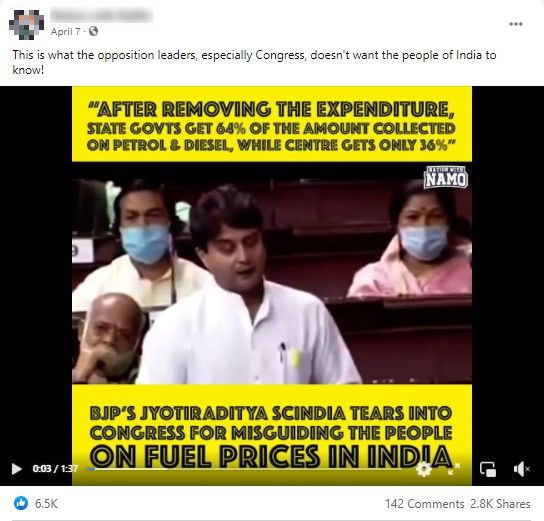
Claim: 64% of the taxes collected on petrol go to the state governments, whereas the center retains only 36 % – Jyotiraditya Scindia.
Fact: Central government levies excise duty of Rs. 32.9 on liter petrol. However, of the total central excise duty, Rs. 32.33 paise i.e. 98.27% is retained by the center and only 1.73% is distributed among all the states. Hence the claim made in the post is FALSE.
While addressing a session in Rajya Sabha on 24 March 2021, BJP’s MP Jyotiraditya Scindia stated that 64% of the taxes levied on petrol go to the states, whereas the central government retains only 36%. However, this is not true as explained below.

Tax breakup on Petrol:
The Central government levies excise duty on petrol in the form of Basic Excise Duty (BED), Special Additional Excise Duty (SAED), Additional Excise Duty (Road & Infrastructure) (AED), and the newly introduced Agriculture & Infrastructure Development Cess (AIDC).
- Of all these levies, Special Additional Excise Duty (SAED) was introduced by the Finance Act 2002. However, as per the act, the amount of excise duty levied under SAED is in the form of surcharge and the amount is completely retained by the Center. What this means is that the amount collected through this Special Additional Excise Duty (SAED) does not form part of the divisible pool, and so the states would not have any share.

- Additional Excise Duty (AED) on petrol was introduced by the Finance Act 1998, also known as Road & Infrastructure Cess. Even this amount is completely retained by the Central Government, as it is categorically mentioned in the act that it is levied in the form of cess and hence will be used for the pre-determined purpose of developing roads & infrastructure. So states will not have any share.
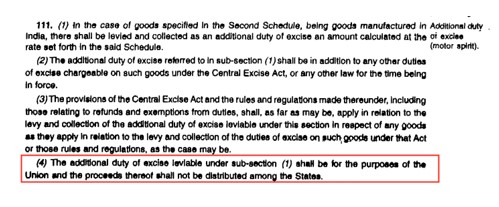
- The Agriculture & Infrastructure Development Cess (AIDC) which was recently introduced in the 2021-22 budget is collected in the form of a cess for a pre-determined purpose (Agricultural Infrastructure) and hence states won’t be entitled to any share in the amount collected in the form of AIDC. Union Finance Minister Nirmala Sitharaman has made it clear in both the Lok Sabha and the Rajya Sabha during the 2021-22 budget debate that tax collected in the form of cess and surcharge will not fall into the divisible pool of distribution.

- This leaves Basic Excise Duty, as the only form of excise duty levied by the central government that falls into the divisible pool wherein the states have a share. The current rate of taxation under different forms of central excise duty can be view in the below table.
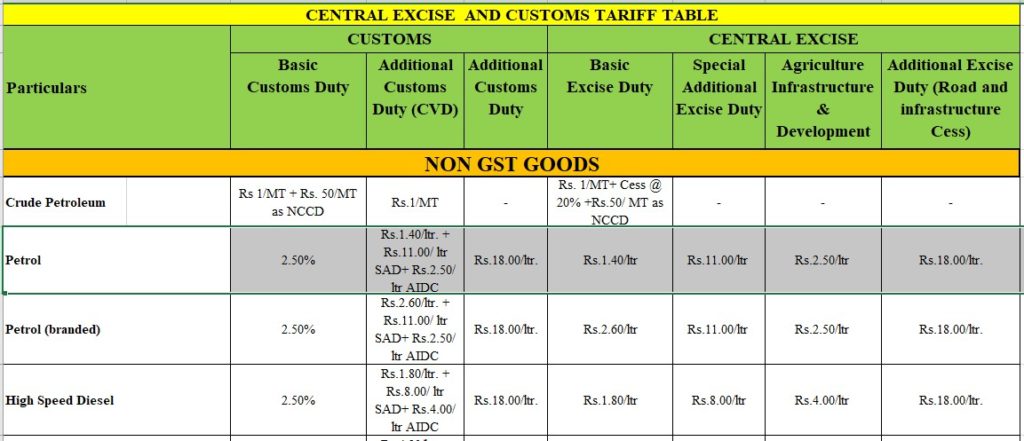
From the above table, we can infer that the sum Rs. 31.50, which is collected in the form of Special Additional Excise Duty (SAED), Additional Excise Duty (Road & Infrastructure) (AED), and Agriculture & Infrastructure Development Cess (AIDC) per liter petrol is completely retained by the center and reaches the central exchequer. The remaining amount Rs. 1.40, which is collected in the form of Basic Excise Duty is the only component that falls under the divisible pool, wherein the states get a share. Out of the total quantum of excise duty i.e. Rs 32.9, only 4.26% (Rs. 1.40, basic excise duty) is distributed among states as per a pre-determined formula recommended by the Finance Commission.
Devolution as per Finance Commission:
The 15th Finance Commission recommended that states get 41% out of the divisible pool of taxes that the central government collects, and the central government retains the remaining 59% (UTs get grants in aid out of this). This means the states receive 41% (i.e. Rs. 0.57) of the Rs. 1.40 Basic Excise Duty levied on petrol and the remaining 59% (i.e. Rs. 0.83) will be retained by the central exchequer.
From the above explanation, we can infer that the total quantum of tax which central government receives per liter petrol is Rs. 32.33 (Rs. 31.5 (cess & surcharge) + Rs. 0.83(center’s share of the divisible pool)). This is static and the same for every state. i.e for every liter sale of petrol in the country, the central government receives Rs. 32.33 as central excise duty.
In other words, of the total taxes levied by the Central Government on liter petrol (i.e. Rs 32.90 paise), 98.27% (i.e. Rs. 32.33 paise) is retained by the center and only 1.73% (i.e. Rs. 0.57) is distributed among all the states.
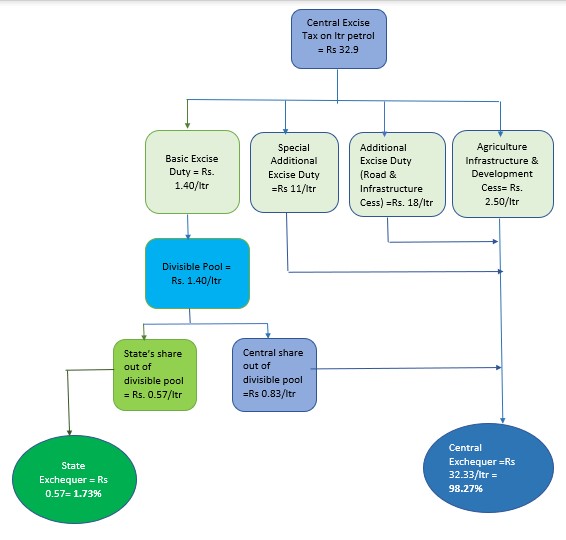
However, each state does not receive 41%, but receives their respective proportion out of the 41% as recommended by the Finance commission. For example, the 15th finance commission has recommended 2.13% as Telangana’s share in the divisible pool, which means Telangana government would receive 2.13% of Rs. 0.57, which amounts to Rs. 0.01 (one paisa) on liter petrol as their share of basic excise duty.
State Govt Tax:
Each state follows its own formula to levy a state tax on the sale of petrol and diesel in their respective states. For example, the Telangana government levies 35.20% VAT, whereas the Andhra Pradesh government levies 31% VAT + Rs.4 / ltr VAT + Rs.1 / ltr road development cess.
Telangana :
Each state follows its own formula to levy a state tax on the sale of petrol and diesel in their respective states. For example, the Telangana government levies 35.20% VAT, whereas the Andhra Pradesh government levies 31% VAT + Rs.4 / ltr VAT + Rs.1 / ltr road development cess.
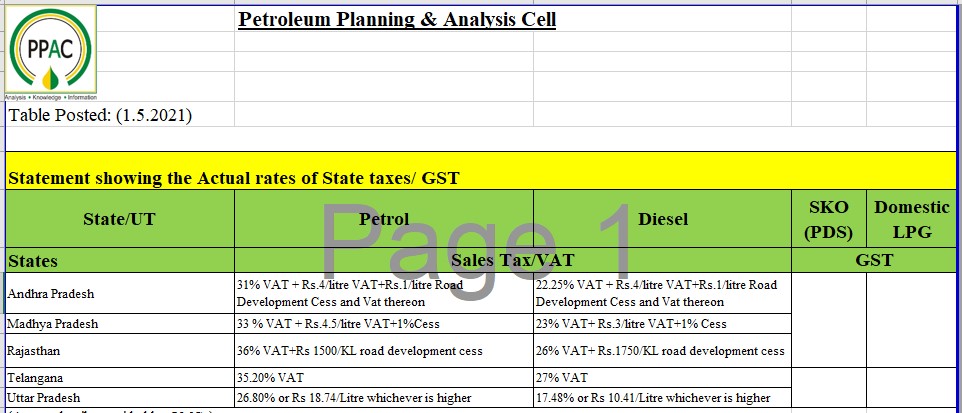
According to the price buildup available on PPAC (Petroleum Planning & Analysis Cell), Telangana state’s 35.20% VAT would amount to Rs. 26.77. In addition to this, the state government would receive its share from the divisible pool of central taxes. In this case, the state government receives Rs 0.01 paise as its share out of the basic excise duty as explained above (2.13% share Rs. 0.57).
Center & State’s share of taxes in Telangana :
The price of liter petrol at any HP petrol pump in Hyderabad on 24 July 2021 is Rs. 105.89 paise. Of this price, both central & states taxes amount to Rs. 59.67.
Out of the total quantum of taxes, Rs. 32.33 is retained by the central exchequer, whereas the state government is entitled to Rs 26.78 (Rs 26.77 state VAT + Rs 0.01 state share of basic excise duty) as explained above. For every liter sale of petrol in Telangana, the state government would receive 44.88% (Rs. 26.78) as their share, whereas the central share is 54.18% (Rs. 32.33) and the remaining 0.94% (Rs. 0.56, remaining after deduction of Telangana State share in Basic Excise Duty) is distributed among other States. This implies the central government receives a greater share of tax amount on petrol compared to the state.
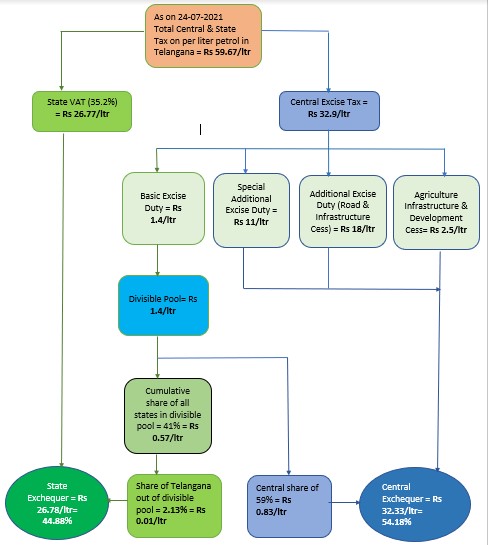
To sum it up, the central government retains 98.3% of central excise duty, whereas the remaining 1.7% is distributed among the states.


